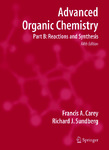Advanced Organic Chemistry
Abstract
The methods of organic synthesis have continued to advance rapidly and we have made
an effort to reflect those advances in this Fifth Edition. Among the broad areas that have
seen major developments are enantioselective reactions and transition metal catalysis.
Computational chemistry is having an expanding impact on synthetic chemistry by
evaluating the energy profiles of mechanisms and providing structural representation
of unobservable intermediates and transition states.
The organization of Part B is similar to that in the earlier editions, but a few
changes have been made. The section on introduction and removal of protecting groups
has been moved forward to Chapter 3 to facilitate consideration of protecting groups
throughout the remainder of the text. Enolate conjugate addition has been moved
from Chapter 1 to Chapter 2, where it follows the discussion of the generalized aldol
reaction. Several new sections have been added, including one on hydroalumination,
carboalumination, and hydrozirconation in Chapter 4, another on the olefin metathesis
reactions in Chapter 8, and an expanded discussion of the carbonyl-ene reaction in
Chapter 10.
Chapters 1 and 2 focus on enolates and other carbon nucleophiles in synthesis.
Chapter 1 discusses enolate formation and alkylation. Chapter 2 broadens the discussion
to other carbon nucleophiles in the context of the generalized aldol reaction, which
includes the Wittig, Peterson, and Julia olefination reactions. The chapter considers
the stereochemistry of the aldol reaction in some detail, including the use of chiral
auxiliaries and enantioselective catalysts.
Chapters 3 to 5 focus on some fundamental functional group modification
reactions. Chapter 3 discusses common functional group interconversions, including
nucleophilic substitution, ester and amide formation, and protecting group manipulations.
Chapter 4 deals with electrophilic additions to double bonds, including the use
of hydroboration to introduce functional groups. Chapter 5 considers reductions by
hydrogenation, hydride donors, hydrogen atom donors, and metals and metal ions.
Chapter 6 looks at concerted pericyclic reactions, including the Diels-Alder
reaction, 1,3-dipolar cycloaddition, [3,3]- and [2,3]-sigmatropic rearrangements, and
thermal elimination reactions. The carbon-carbon bond-forming reactions are emphasized
and the stereoselectivity of the reactions is discussed in detail.

